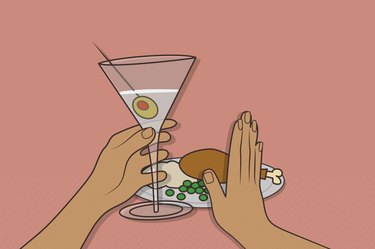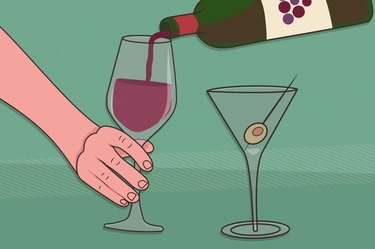
There's a commonly held belief that cheap hooch tastes harsher and hits you with harder hangovers than name-brand alcoholic beverages. As the logic goes, if you stick to sipping liquor that's expensive, you're less likely to wake up with a wicked headache.
But does bottom-shelf booze really take a more terrible toll on your body?
Video of the Day
Video of the Day
We spoke to experts to discover whether spending a few extra dollars on your mixed drinks can decrease your odds of experiencing any misery the morning after a cocktail session.
First Things First, Does Low Price Automatically Equal Low Quality?
"Not at all," says Gary Pickard, a certified spirits educator and member of the Society of Wine Educators.
While we often associate a product's premium price with its quality, this is often nothing more than a misconception, especially when it comes to alcohol.
"Several factors must be considered when talking about price versus quality in alcohol," Pickard says. "Name recognition and celebrity endorsements (particularly in the last few years) can command a big premium, even if the actual product might be inferior in quality to a lesser-known one. And people will pay for the 'cool' factor, especially if their spirit is [featured] in a hit song or a memorable commercial with a famous face."
"Some aspects of production also have a direct influence on the cost of a bottle," Pickard says. For example, the amount of time a spirit is aged plays an important part in the price. But an older spirit isn't automatically a better one, he says.
Pickard explains: "Every year that a spirit spends in a barrel, it loses a percentage of volume to evaporation, known as the 'angel's share.' Quite simply, the longer that a spirit ages, the scarcer it becomes in comparison to its initial barrel fill level."
And this scarcity — not the actual quality — is the source of the surging price point. So, keep in mind that a cheaper price isn't always an accurate predictor of a spirit's true value.
Do Distillation and Filtration Affect Quality?
A lot of claims about quality tend to be correlated with a liquor's distillation and filtration methods. Here's a quick primer on the basics of both processes.
Distillation
In the simplest terms, distillation involves heating alcohol to separate it from water. Once the alcohol vaporizes, it's collected and recondensed into liquid form.
"Since different types of alcohols have different boiling points, as the temperature increases on the spirit still, we collect different distillates," Pickard says. These can be broken into three categories:
- The foreshots or heads come off the still first and are the most volatile compounds (containing methanol, acetaldehyde, acetone and more).
- The heart of the run is next. This is the "good stuff," i.e., the purest drinking alcohol (mostly ethyl alcohol/ethanol).
- The tails (fusel alcohols, acetic acid, furfural and more) come last. These are less volatile and contain some flavor compounds but are mostly re-distilled in another batch.
Filtration
Filtration is another way to remove and limit a liquor's impurities. "Think of it like putting the spirit through a big Brita filter," Pickard says.
"Brands tend to be either fairly secretive or very loud about their filtration processes," he says. "You hear about ultra-premium and luxury vodkas filtering with everything from diamonds to gold and platinum."
But "as long as some type of carbon-based filtration is happening at some level, it should knock some of the 'rough edges' off of the spirit," he says.
Is Cheap Alcohol Worse Than Pricy Liquor?
While price isn't always a proxy for value, some "recent research findings highlight that when it comes to hangovers and other such negative side effects of various liquors, if that bottle is the cheapest on the rack, chances are you may be in for a worse hangover," says Laura J. Veach, PhD, a licensed clinical addiction specialist and professor at Wake Forest University School of Medicine.
Let's look at how a liquor's quality — which may or may not be related to its price tag — factors into how it makes you feel.
1. Cheap Liquor May Contain More Harmful Byproducts
"In the aging of distilled spirits, a number of byproducts are produced from the fermenting process," Veach says. Called congeners, these undesirable compounds include chemicals such as methanol, acetaldehydes and tannins.
These chemicals are likely responsible for the adverse effects that we associate with drinking alcohol (think: hangovers and headaches), Pickard says. And certain congeners are terribly toxic. For example, even minuscule amounts of methanol (between 2 and 8 ounces) can cause blindness, permanent organ damage or death, according to Mount Sinai.
So it goes without saying: "The more of these undesirable chemical byproducts [that make it into the final product], the greater the likelihood of a nastier hangover [or other unwanted side effects]," Veach says.
Indeed, some studies show that boozy beverages that boast the highest congener content, like dark liquors, result in more severe hangover ratings than cocktails with fewer congeners, per a June 2010 review in Current Drug Abuse Reviews.
So how do congeners relate to alcohol quality? In general, more expensive liquor brands tend to use higher-quality filtering processes to remove these by-products, Veach says.
Similarly, some liquor brands also claim to distill their spirits seven, 25 or 100 times, Pickard says. In theory, if you repetitively distill the same liquid, the distillate will increase in purity.
But it takes a lot of dollars to distill this many times, a luxury that low-end liquor brands may not have. "If there is pressure to get more yield from a distillation run for monetary purposes," a company may need to cut costs, Pickard says. And one cost-effective strategy could be to perform fewer rounds of distillation.
Put another way, a brand may get a greater yield of a product by "widening the cut" to incorporate more of the heads and tails. "But the quality will not be as pure and will contain other compounds," Pickard says. This could explain why cheaper spirits are sometimes rougher to drink.
That being said, distillers must follow certain federal regulations and no above-board brand would permit anything overtly harmful (like methanol) into a final product, he adds.
Plus, "congener doesn't have to be a dirty word," Pickard says. "In fact, there are wonderful congeners that we rely on to provide flavors."
For example, "compounds like vanillin, eugenol, diacetyl and hundreds of others can respectively give us flavor profiles that we are looking for, like vanilla, clove and butter," he says.
"In some products, there is a concentrated effort to add these flavorful congeners to the process," Pickard says. Alternatively, some companies will choose to distill at a lower level to retain the flavors of the original ingredients and compounds from the fermentation process. This is often the case for spirits such as whisky, brandy, tequila and rum, he says.
Perhaps this intentional distillation decision explains why some data demonstrates that darker liquors (like whisky, brandy and certain kinds of tequila and rum) may contain a greater concentration of congeners, Veach says.
Still, "there is such wide variation in the aging process of various liquors that the consumer cannot know of the congener content just by looking at the color," she adds.
2. Low-Quality Liquor May Contain Substandard Ingredients
"If a producer decides to make a more cost-effective liquor, the cost of production needs to be reduced somewhere," Pickard says. "And one of the easiest ways to do that (besides widening your cuts in distillation) is to cut costs on the quality of the raw ingredients used."
As you've probably guessed, this can have a negative effect on the final product. "Just like in cooking, the final dish will only be as good as the fresh ingredients that you use," Pickard says.
For example, "subpar grains or fruits have the potential to give off more unwanted compounds and off-flavors during the fermentation process," Pickard says. Translation: Your booze may contain more hangover-inducing congeners and taste harsher on your tongue.
Making matters worse, these inferior ingredients can also be contaminated with mildew and bacteria, he adds.
3. Cheap Alcohol May Contain More Additives
Companies may add dyes, synthetic flavorings, processed sugars and other substances to your spirits to make them look a certain way or enhance their taste. And this might be more likely in lower-end liquors.
"Putting more additives in your final product might be a cheap and fast way to mask any problems producers might have with fermentation or distillation," Pickard says.
Case in point: "Some dark spirits (where legally allowed) might choose to utilize what is known as E150, otherwise known as caramel coloring or spirit coloring, to maintain consistency between batches or to achieve a darker appearance," Pickard says.
While dyes may make your food or drinks appear more appealing, preliminary research has found that they can possibly pose harm to your health.
For example, a November 2013 review in the International Journal of Occupational and Environmental Health found that some food dyes are correlated with carcinogenicity, genotoxicity and hypersensitivity in animals. Though more human studies are necessary to better understand this link, it's probably best not to drink spirits with dyes as they don't add any nutritional quality to foods or beverages anyway.
Similarly, brands also boost the taste of their booze by including extra sugars. The sugar alcohol "glycerin can be used in many spirits to add sweetness and provide viscosity, or a richer mouthfeel," Pickard says.
While sweeteners aren't directly responsible for hangovers, sugars can make your spirits go down more smoothly. Put simply: They make liquor more palatable, so you're more prone to push too far and drink too much.
And if you make sipping on sugary stuff a habit, you'll have more than just a hounding headache to contend with as excessive sugar can increase inflammation in the body.
Still, "these little shortcuts aren't just used by your bottom-shelf producers," Pickard says. "Some of the most expensive and exclusive liquor in the world can legally contain additives and artificial coloring."
Quantity Versus Quality
Still, both Pickard and Veach agree that how much you drink — versus the quality of your liquor — is more likely to cause adverse effects.
In addition to run-of-the-mill headaches and hangovers, a night of binge drinking can also bring on symptoms such as general malaise, tachycardia (rapid heart rate), uneasiness, difficulty concentrating, oversensitivity to light and sound, excessive thirst, nausea and vomiting, Veach says.
An episode of heavy drinking can also influence your mental and emotional state, contributing to depressed mood, anxiety and irritability, she adds.
This effect on mental health possibly relates to the way the brain processes alcohol. For example, "dopamine — our naturally occurring 'feel good' brain chemical — is depleted as alcohol is eliminated from the body, which may result in increased anxiety or uneasiness," Veach says.
And the more liquor you throw back, the more likely the negative effects. Thing is, many studies demonstrate that people have a stronger tendency to overdrink when drinks are cheaper, Veach says.
"College students, in particular, have been found to engage in more binge drinking when liquor shots are sold at below price points, leading to an increased risk of traumatic injuries, such as falls, sexual assaults, violence and motor vehicle accidents," she says.
All this to say, the real harm of bad quality booze appears to be the way people binge it versus what's in it.
Matter of fact, preliminary studies show that ethanol (the purest part of the alcohol) is still the primary source of side effects such as hangovers rather than the congener content typically associated with bottom-of-the-barrel brews, per the 2010 review in Current Drug Abuse Reviews.
Still, Veach cautions that hangover research remains an evolving science, and more evidence is needed to assess the role of congeners and cheaper ingredients (as compared to alcohol itself, a known neurotoxin).
So, How Bad Is It Really to Drink Cheap Liquor?
At times, a bargain-basement brew may hit you harder than booze you pay big bucks for, but a bottle's cheapness isn't always a reliable gauge of how it'll affect you physically.
When it comes to liquor, "price point is not the be-all and end-all quality indicator," Pickard says. "With hundreds of millions of dollars being invested in beverage alcohol marketing and advertising every year, it is not a level playing field."
In other words, just because a bottle is less expensive doesn't mean it's of poorer quality than a tried-and-true name brand. "New brands generally need to price products lower to push consumer trial and gain visibility," Pickard says.
And while lower quality liquors may, in certain cases, contain more congeners, additives and mediocre ingredients, they're not unsafe to sip. "As bad as some extremely cheap products on the market might be, they all undergo testing, filing and scrutiny from governmental agencies to ensure consumer safety," Pickards says.
"Even if they might be rougher or harsher in nature, they are still safe for consumption, as long as the consumption is done in moderation," he adds.
The moral of the story: To avoid an angry hangover and other harmful side effects, know your limits and drink responsibly — whether it's bottom-shelf booze or premium spirits.
Was this article helpful?
150 Characters Max
0/150
Thank you for sharing!
Thank you for your feedback!



